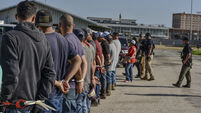Majestic creatures patrolling our road network
Well, I seem to be in a minority because I’ve had lots of emails and letters from people all around the country who see kestrels on a regular basis.
This is good news. Maybe they haven’t become as rare as I feared. They are very beautiful little falcons and their habit of hovering when they’re hunting, described in the famous poem by Gerard Manley Hopkins, is fascinating to watch.
One reader, who seems to drive around the country a lot, tells me he often sees them when he’s on a motorway. This is something that’s been commented on in Britain for some time now — Britain has had a motorway network for far longer then we have.
Kestrels mainly hunt small mammals like mice, voles and shrews. Motorway verges and medians tend to develop rough grass with some trees and shrubs. In fact their botany can be surprisingly interesting if management is not too intense. This is ideal habitat for small mammals, much better than most farmland, and kestrels have learnt this and developed the habit of hunting along motorways. The fact that I don’t see them is because I’m usually the driver and birdwatching at 120kph is a poor idea.
Another reader describes two kestrels perched on adjoining telephone posts and remarks that they seemed to be about the same size so he assumed they were of the same sex.
In fact with kestrels, unlike sparrow hawks, the male and female are approximately the same size. The main difference between them is that adult males have a blue-grey crown, rump and tail while these are a red-brown colour in the females. If a bird is hovering and you’re beneath it it’s quite difficult to tell the sexes apart.
I also had an email from a reader on the Beara Peninsula who has a pair of jays visiting his bird table. One bird lands and stuffs its crop with a huge number of peanuts. The other queues patiently and then flies down and does the same. When they leave a pair of coal tits arrive and start removing the remaining peanuts.
This makes sense. Jays and coal tits are the two species of Irish bird that really believe in building up stores of food for future use. Jays usually bury their caches while coal tits look for a hollow in a tree or a crevice in rocks to use as a store house. Because both species are using the same bird table there could be a big bill for peanuts.
I was interested to learn that there is a population of jays on the Beara Peninsula. They are by no means a common bird and usually associated with woodland. It’s a few years since I’ve been to Beara but I don’t remember much in the way of woodland. But then jays have been on the move in the past couple of decades.
At one stage they were concentrated in the east, particularly the south east. But there has been a steady movement westward. They were first recorded in west Donegal about fifteen years ago and now it appears they’re in West Cork.
My belief, though I can’t prove this, is that they are moving west to avoid competition from grey squirrels. The bird and the mammal have very similar diets — nuts, seeds, buds and the occasional bird’s egg. But the invading grey squirrel has largely failed to go west, so that’s where the jays are heading.
* dick.warner@examiner.ie













